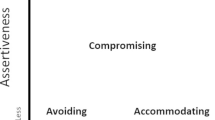Abstract
Although the development of collaborative relationships is considered a requirement for medical education, the functioning of these relationships may be impaired by a well-documented social-psychological phenomenon known as group conformity. The authors hypothesized that students would insert a needle into an incorrect location relative to the patella when performing a knee arthrocentesis if they believed that their peers had also inserted a needle in the same incorrect location. This was a randomized controlled study conducted in 2011 with 60 medical students (24 male; 40.0 %) who were randomly assigned to either using a knee model that had a skin with holes left by peers inserting needles in the wrong location, or a knee with no marks in the skin. Each student’s aspiration site was measured with a fibreglass ruler to determine whether it was correctly located within the superior third, 1 cm medial to the patella. The researchers determined that students who used the marked skin were more likely to insert the needle in the incorrect location compared to those who used the clean skin (n = 31, 86.11 vs. n = 14, 58.33 %), Fisher’s exact test (1) = 5.93, p < 0.05, Cramer’s ϕ = 0.31. This study demonstrates incorrect performance of the knee arthrocentesis procedure in simulation when students use a damaged model, which may be due to conformity. It suggests that further research on the impact of conformity in medical education is warranted.

Similar content being viewed by others
References
Asch, S. E. (1952). Effects of group pressure on the modification and distortion of judgments. In G. E. Swanson, T. M. Newcomb, & E. L. Hartley (Eds.), Readings in social psychology (2nd ed., pp. 2–11). New York: Holt.
Asch, S. E. (1955). Opinions and social pressure. Scientific American, 193, 33–35.
Asch, S. E. (1956). Studies of independence and conformity. A minority of one against a unanimous majority. Psychological Monographs, 70(9), 416.
Bartlett, G., Blais, R., Tamblyn, R., Clermont, R. J., & MacGibbon, B. (2008). Impact of patient communication problems on the risk of preventable adverse events in acute care settings. Canadian Medical Association Journal, 178(12), 1555–1562.
Berry, J. W. (1967). Independence and conformity in subsistence-level societies. Journal of Personality and Social Psychology, 7, 415–418.
Boldt, E. D. (1976). Acquiescence and conventionality in a communal society. Journal of Cross Cultural Psychology, 7, 21–36.
Canadian Medical Association. (2007). Putting patients first: Patient-centred collaborative care—A discussion paper. Retrieved 23, July 2012 from http://fhs.mcmaster.ca/surgery/documents/CollaborativeCareBackgrounderRevised.pdf.
Cramér, H. (1999). Mathematical methods of statistics. Princeton, NJ: Princeton University Press.
de Vries, E. N., Ramrattan, M. A., Smorenburg, S. M., et al. (2008). The incidence and nature of in-hospital adverse events: A systematic review. Quality & Safety in Health Care, 17(3), 216–223.
Doms, M., & van Avermaet, E. (1981). The conformity effect: A timeless phenomenon? A reply to perrin and spencer. Bulletin of the British Psychology Society, 34, 383–385.
Glaser, B., & Strauss, A. (1967). The discovery of grounded theory: Strategies for qualitative research. Chicago, IL: Aldine Publishing.
Guo, Z., Tan, F. B., Turner, T., & Xu, H. Z. (2010). Group norms, media preferences, and group meeting success: A longitudinal study. Computers in Human Behavior, 26(4), 645–655.
Harden, R. M., Crosby, J. R., & Davis, M. H. (1999). Association for medical education in Europe guide no. 14: Outcome-based education: Part 1D an introduction to outcome-based education. Medical Teacher, 21(1), 7–14.
Henriksen, K., & Dayton, E. (2006). Organizational silence and hidden threats to patient safety. Health Services Research, 41(4 Pt 2), 1539–1554.
Hodges, B. D., & Kuper, A. (2012). Theory and practice in the design and conduct of graduate medical education. Academic Medicine, 87, 25–33.
Kennedy, T. J. T., Regehr, G., Baker, G. R., Lingard, L. (2009). “It’s a cultural expectation…”: The pressure on medical trainees to be independent in clinical work. Medical Education, 43(7), 645–653.
Martin, C. (2011). Perspective: To what end communication? Developing a conceptual framework for communication in medical education. Academic Medicine, 86, 1566–1570.
Mori, K., & Arai, M. (2010). No need to fake it: Reproduction of the Asch experiment without confederates. International Journal of Psychology, 45(5), 390–397.
Neto, E. (1955). Conformity and independence revisited. Social Behavior and Personality, 23, 217–222.
Pian-Smith, M. C., Simon, R., Minehart, R. D., Podraza, M., Rudolph, J., Walzer, T., et al. (2009). Teaching residents the two-challenge rule: A simulation-based approach to improve education and patient safety. Simulation in Healthcare, 4(2), 84–91.
Thomsen, T. W., Shen, S., Shaffer, R. W., & Setnik, G. S. (2006). Arthrocentesis of the knee. New England Journal of Medicine, 354, e19.
Tversky, A., & Kahneman, D. (1974). Judgment under uncertainty: Heuristics and biases. Science, 185(4157), 1124–1131.
Wright, D. B., London, K., & Waechter, M. (2010). Social anxiety moderates memory conformity in adolescents. Applied Cognitive Psychology, 24(7), 1034–1045.
Acknowledgments
The authors wish to thank Dr. Claudio Violato for initiating the idea for this project, and Dr. Irene Ma for assisting with the research design and manuscript revisions.
Conflict of interest
None.
Author information
Authors and Affiliations
Corresponding author
Rights and permissions
About this article
Cite this article
Beran, T.N., McLaughlin, K., Al Ansari, A. et al. Conformity of behaviors among medical students: impact on performance of knee arthrocentesis in simulation. Adv in Health Sci Educ 18, 589–596 (2013). https://doi.org/10.1007/s10459-012-9397-5
Received:
Accepted:
Published:
Issue Date:
DOI: https://doi.org/10.1007/s10459-012-9397-5




